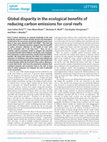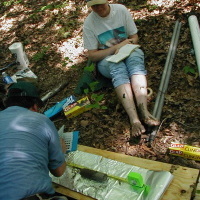Papers by Christopher Doropoulos
Ecological Monographs, 2015
Marine Ecology Progress Series, 2015

Coral Reefs, 2015
Environmental conditions play an important role in post-disturbance dynamics of ecosystems by mod... more Environmental conditions play an important role in post-disturbance dynamics of ecosystems by modulating recovery of surviving communities and influencing patterns of succession. Here, we document the effects of wave exposure following a catastrophic disturbance on coral reefs in driving a phase shift to macroalgal dominance. In December 2012, a Category 5 super typhoon ('Typhoon Bopha') passed 50 km to the south of Palau (Micronesia), causing a major loss of reef corals. Immediately post-disturbance, a rapid and extensive phase shift of the macroalgae Liagora sp. (Rhodophyta) was observed at sites exposed to chronic wave exposure. To quantify the influence of biotic and abiotic drivers in modulating the extent of post-disturbance Liagora blooms, we compared benthic substrates and herbivore assemblages at sites surveyed pre-and post-disturbance across a gradient of wave exposure. Relative changes in herbivore biomass and coral cover before and after disturbance did not significantly predict the extent of Liagora cover, indicating that changes in herbivore biomass or reductions in grazing pressure were not directly responsible for driving the Liagora blooms. By contrast, the degree of wave exposure experienced at sites post-disturbance explained [90 % of model variance (p \ 0.001, R 2 = 0.69), in that Liagora was absent at low exposure sites, while most extensive blooms were observed at highly exposed sites. At regional scales, spatial maps of wave exposure accurately predicted the presence of Liagora at impacted sites throughout the Palau archipelago ([150 km distance), highlighting the predictive capacity of wave exposure as an explanatory variable and the deterministic nature of postdisturbance macroalgal blooms. Understanding how physical conditions modulate recovery of ecosystems after disturbance allows insight into post-disturbance dynamics and succession of communities, ultimately allowing management strategies to prioritise restoration efforts in regions that are most effective.

Oecologia, 2015
While positive interactions have been observed to influence patterns of recruitment and successio... more While positive interactions have been observed to influence patterns of recruitment and succession in marine and terrestrial plant communities, the role of facilitation in macroalgal phase shifts is relatively unknown. In December 2012, typhoon Bopha caused catastrophic losses of corals on the eastern reefs of Palau. Within weeks of the typhoon, an ephemeral bloom of monospecific macroalgae (Liagora sp.) was observed, reaching a peak of 38.6 % cover in February 2013. At this peak, we observed a proliferation of a second macroalgal species, Lobophora variegata. Lobophora was distributed non-randomly, with higher abundances occurring within the shelter of Liagora canopies than on exposed substrates. Bite rates of two common herbivorous fish (Chlorurus sordidus and Ctenochaetus striatus) were significantly higher outside canopies (2.5- and sixfold, respectively), and cage exclusion resulted in a significant increase in Lobophora cover. Experimental removal of Liagora canopies resulted in a 53.1 % decline in the surface area of Lobophora after 12 days, compared to a 51.7 % increase within canopies. Collectively, these results indicate that Liagora canopies act as ecological facilitators, providing a 'nursery' exclusion zone from the impact of herbivorous fish, allowing for the establishment of understory Lobophora. While the ephemeral Liagora bloom had disappeared entirely 9 months post-typhoon, the facilitated shift to Lobophora has persisted for over 18 months, dominating ~40 % of the reef substrate. While acute disturbance events such as typhoons have been suggested as a mechanism to reverse algal phase shifts, our results suggest that typhoons may also trigger, rather than just reverse, phase shifts.
formation and fertile tissue area in a 'Reproductive success factor' clearly indicated that induc... more formation and fertile tissue area in a 'Reproductive success factor' clearly indicated that induction of sporogenesis in L. digitata is a cold-adapted process. Even only slight increases in summer water temperatures will probably have a negative effect on this kelp population in the future.

PLOS ONE, 2015
Tropical reefs are dynamic ecosystems that host diverse coral assemblages with different life-his... more Tropical reefs are dynamic ecosystems that host diverse coral assemblages with different life-history strategies. Here, we quantified how juvenile (<50 mm) coral demographics influenced benthic coral structure in reef flat and reef slope habitats on the southern Great Barrier Reef, Australia. Permanent plots and settlement tiles were monitored every six months for three years in each habitat. These environments exhibited profound differences: the reef slope was characterised by 95% less macroalgal cover, and twice the amount of available settlement substrata and rates of coral settlement than the reef flat. Consequently, post-settlement coral survival in the reef slope was substantially higher than that of the reef flat, and resulted in a rapid increase in coral cover from 7 to 31% in 2.5 years. In contrast, coral cover on the reef flat remained low (~10%), whereas macroalgal cover increased from 23 to 45%. A positive stock-recruitment relationship was found in brooding corals in both habitats; however, brooding corals were not directly responsible for the observed changes in coral cover. Rather, the rapid increase on the reef slope resulted from high abundances of broadcast spawning Acropora recruits. Incorporating our results into transition matrix models demonstrated that most corals escape mortality once they exceed 50 mm, but for smaller corals mortality in brooders was double those of spawners (i.e. acroporids and massive corals). For corals on the reef flat, sensitivity analysis demonstrated that growth and mortality of larger juveniles (21-50 mm) highly influenced population dynamics; whereas the recruitment, growth and mortality of smaller corals (<20 mm) had the highest influence on reef slope population dynamics. Our results provide insight into the population dynamics and recovery trajectories in disparate reef habitats, and highlight the importance of acroporid recruitment in driving rapid increases in coral cover following large-scale perturbation in reef slope environments.

Nature Climate Change, 2014
Even if carbon emissions are reduced drastically in the next decade the amount of carbon already ... more Even if carbon emissions are reduced drastically in the next decade the amount of carbon already stored in the atmosphere would lead to the occurrence of extreme thermal events every three to four years between 2040 and 2080 1,2 . This time lag on the e ect of reducing emissions suggests that the benefits of carbon emission reduction on the health of coral reefs will be noticeable only in the long term 2-4 . Here, we use a spatially explicit ecosystem model to compare the potential ecosystem benefits that Caribbean and Pacific reefs could gain from reductions in carbon emissions, and the timescale of these benefits. We found that whereas the e ect of a reduction in emissions on Caribbean reefs will be modest and realized only in the long term (more than 60 years), Pacific reefs would start to show benefits within the first half of this century. Moreover, it seems that Pacific reefs have the potential to maintain their ecological integrity and ecosystem state in the mid-to long term if carbon emissions are reduced, but only if plate-like corals are present.
PLoS ONE, 2011
Background: Patterns of herbivory can alter the spatial structure of ecosystems, with important c... more Background: Patterns of herbivory can alter the spatial structure of ecosystems, with important consequences for ecosystem functions and biodiversity. While the factors that drive spatial patterns in herbivory in terrestrial systems are well established, comparatively less is known about what influences the distribution of herbivory in coral reefs.
Marine Ecology Progress Series, 2013

Marine Ecology Progress Series, 2013
Coral reefs can exist as coral-and macroalgae-dominated habitats often separated by only a few hu... more Coral reefs can exist as coral-and macroalgae-dominated habitats often separated by only a few hundred metres. While herbivorous fish are known to depress the abundance of algae and help maintain the function of coral-dominated habitats, less is known about their influence in algae-dominated habitats. Here, we quantified herbivorous fish and benthic algal communities over a 6 mo period in coral-dominated (back-reef) and algal-dominated (lagoon) habitats in a relatively undisturbed fringing coral reef (Ningaloo, Western Australia). Simultaneously, we tested the effects of herbivorous fish on algal recruitment in both habitats using recruitment tiles and fish exclusion cages. The composition of established algal communities differed consistently between habitats, with the back-reef hosting a more diverse community than the Sargassum-dominated lagoon. However, total algal biomass and cover only differed between habitats in autumn, coinciding with maximum Sargassum biomass. The back-reef hosted high coral cover and a diverse herbivorous fish community, with herbivore biomass an order of magnitude greater than the lagoon. Despite these differences in herbivore composition, exclusion of large herbivores had a similar positive effect to foliose macroalgae recruitment on experimental tiles in both back-reef and lagoon habitats. Additionally, territorial damselfish found in the backreef increased turf algae cover and decreased crustose coralline algae cover on recruitment tiles. Collectively, our results show that disparate herbivorous fish communities in coral-and algaedominated habitats are similarly able to limit the recruitment of foliose macroalgae, but suggest that when herbivorous fish biomass and diversity are relatively low, macroalgal communities are able to escape herbivore control through increased growth.
Marine Ecology Progress Series, 2012

Estuarine, Coastal and Shelf Science, 2009
The movement of allochthonous resources between habitats can provide important trophic linkages i... more The movement of allochthonous resources between habitats can provide important trophic linkages in marine landscapes. In coastal south-western Australia, the kelp Ecklonia radiata is removed from reefs and accumulates in large quantities in neighbouring seagrass meadows. This study investigated the feeding preferences and grazing rates of two locally abundant gastropods, Pyrene bidentata and Cantharidus lepidus, which exhibit inverse distribution patterns with proximity to reefs in seagrass meadows, to determine whether allochthonous kelp has the potential to contribute to the seagrass food web. Using laboratory choice and no-choice feeding experiments, we tested whether detached kelp is consumed preferentially, and at greater rates, by these two species than autochthonous resources (i.e. seagrass, epiphytic red macroalgae and seagrass periphyton). Both species displayed a preference for macroalgae and seagrass periphyton over seagrass leaves. In choice experiments, neither species displayed any clear preference between kelp (fresh or aged), red macroalgae or periphyton (consumption rates ranged between 0.39 and 3.64 mg ind À1 day À1 ), but consumption rates were always higher relative to seagrass. In no-choice experiments, P. bidentata displayed minimal consumption of seagrass, but consumed fresh and aged kelp, red macroalgae and seagrass periphyton at similar rates (2.00-7.22 mg ind À1 day À1 ). In comparison, C. lepidus consumed periphyton at far greater rates than any other food source (3.61 vs 0.33-1.10 mg ind À1 day À1 ). The results indicate that both P. bidentata and C. lepidus showed a clear preference for macroalgae and periphyton over seagrass, but no consistent preference towards any autochthonous or allochthonous algal resource. Reef-derived kelp therefore has the potential to contribute to the food web of seagrass meadows, and subsidise secondary production.

The Biological bulletin, 2014
Calcification and growth of crustose coralline algae (CCA) are affected by elevated seawater pCO2... more Calcification and growth of crustose coralline algae (CCA) are affected by elevated seawater pCO2 and associated changes in carbonate chemistry. However, the effects of ocean acidification (OA) on population and community-level responses of CCA have barely been investigated. We explored changes in community structure and population dynamics (size structure and reproduction) of CCA in response to OA. Recruited from an experimental flow-through system, CCA settled onto the walls of plastic aquaria and developed under exposure to one of three pCO2 treatments (control [present day, 389±6 ppm CO2], medium [753±11 ppm], and high [1267±19 ppm]). Elevated pCO2 reduced total CCA abundance and affected community structure, in particular the density of the dominant species Pneophyllum sp. and Porolithon onkodes. Meanwhile, the relative abundance of P. onkodes declined from 24% under control CO2 to 8.3% in high CO2 (65% change), while the relative abundance of Pneophyllum sp. remained constant....











Uploads
Papers by Christopher Doropoulos